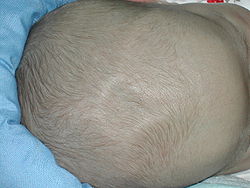Anterior fontanelle
| Anterior fontanelle | |
|---|---|

Skull at birth, showing frontal and occipital fonticuli.
|
|

Human anterior fontanelle 1 month
|
|
| Details | |
| Identifiers | |
| Latin | fonticulus anterior |
| TA | A02.1.00.028 |
| FMA | 75439 |
|
Anatomical terminology
[]
|
|
The anterior fontanelle (bregmatic fontanelle, frontal fontanelle) is the largest fontanelle, and is placed at the junction of the sagittal suture, coronal suture, and frontal suture; it is lozenge-shaped, and measures about 4 cm in its antero-posterior and 2.5 cm in its transverse diameter. The fontanelle allows the skull to deform during birth to ease its passage through the birth canal and for expansion of the brain after birth.
While the posterior and lateral fontanelles are obliterated by about six months after birth, the anterior is not completely closed until about the middle of the second year. Full ossification starts in the late twenties and finishes before the age of 50 .
The anterior fontanelle is useful clinically. Examination of an infant includes palpating the anterior fontanelle. A sunken fontanelle indicates dehydration, whereas a very tense or bulging anterior fontanelle indicates raised intracranial pressure. However, this is not a certain indicator for raised pressure as prolonged crying by the baby may produce the same effect. A full anterior fontanelle may also be indicative of neonatal meningitis, specifically acute bacterial meningitis.
Skull of newborn. Anterior view.
...
Wikipedia
